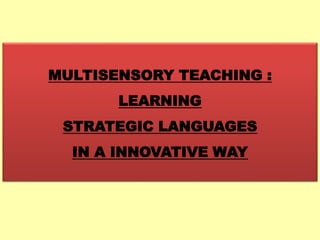
Multisensory Teaching : Learning in a innovative way
- 1. MULTISENSORY TEACHING : LEARNING STRATEGIC LANGUAGES IN A INNOVATIVE WAY
- 2. AIM • To understand the nuances of multisensory teaching and its usage in learning strategic languages.
- 3. PREVIEW • Part I - Multi-sensory Teaching-Meaning and Importance. • Part II - Learning styles and Quick Facts. • Part III - Rationale for the Use of Multi-Sensory Teaching. • Part IV - The Different Teaching and Learning Techniques. • Part V - Beneficiaries from Multi-Sensory Learning. • Part VI - Tips for Creating a Multi-Sensory Classroom.
- 4. MULTI-SENSORY TEACHING : MEANING & IMPORTANCE • Multisensory teaching techniques and strategies stimulate learning by engaging students on multiple levels. • They encourage students to use some or all their senses to:- – Gather information about a task. – Link information to ideas they already know and understand. – Perceive the logic involved in solving problems. – Learn problem solving tasks. – Tap into nonverbal reasoning skills. – Understand relationships between concepts. – Store information and store it for later recall.
- 5. LEARNING STYLES AND QUICK FACTS ABOUT MULTI-SENSORY LEARNING • Learning Styles. Researchers suggest that many students have an area of sensory learning strength, called a learning style. – When students are taught using techniques consistent with their learning styles, they learn more easily & faster. – Can retain and apply concepts more readily to future learning. – Most students, with a difficulty or not, enjoy the variety that multisensory techniques can offer.
- 6. QUICK FACTS • Integrates visual, auditory, tactile (touch) and kinesthetic (movement) learning elements. • Different teaching methods activate different parts of the brain. • Helps learners discover their learning style and the techniques best for them. • Effective for all learners but particularly effective for dyslexic students. • Can be used in any subject from reading to math to science and drama. • Allows for more individualized lesson planning. • Enabled more and more by assistive technology see, hear, touch and move your way to understanding.
- 7. RATIONALE FOR THE USE OF MULTI- SENSORY TEACHING • Students exhibit weaknesses in underlying language skills involving speech sound (phonological) and print (orthographic) processing. • Most students with dyslexia have weak phonemic awareness, meaning they are unaware of the role sounds play in words. • Because of their trouble establishing associations between sounds and symbols, they have trouble learning to recognise words automatically (“by sight”) or fast enough to allow comprehension. • Dyslexic children and teens need specialised instruction to master the alphabetic code and to form those memories. • This multi-sensory part remains one of the most reliable method for a dyslexic mind to learn to spell, read and write because it fully engages the each part of the brain. • Another positive about this method is that it also works for teaching mathematics as well.
- 8. DIFFERENT TEACHING & LEARNING TECHNIQUES • Visual Teaching: Students to learn by seeing. • Auditory Teaching: Students to learn by listening. • Tactile Teaching: Students to learn by touching. • Kinesthetic Teaching: Students to learn while moving. • Sequential Teaching: Students to learn material in a specific order or s eries of steps. • Simultaneous Teaching: Students to learn “how the information is interrelated.
- 9. DIFFERENT TEACHING & LEARNING TECHNIQUES • Reflective/Logical Teaching: Students solve problems and ponder complex issues. • Verbal Teaching: Students learn info by talking about it. • Interactive Teaching: Students learn info in the company of others . • Direct Experience Teaching: Students learn through experience. • Indirect Experience Teaching: Students learn from the experiences o f others. • RhythmicTeaching: Students see patterns or pair melodies and rhythm.
- 10. • Kids can benefit from multi-sensory lessons, If a student learns something using more than one sense, the information is more likely to stay with him. • People with learning disabilities have trouble with language skills involving speech sound (phonological) and print (orthographic) processing and in building pathways that connect speech with print. • People with sensory integration challenges sense information normally but have difficulty perceiving and processing that information because it is analyzed in their brains in a different way. • Multi-sensory learning can be particularly helpful for kids with learning and attention issues. BENEFICIARIES FROM MULTI-SENSORY LEARNING
- 11. • Writing homework assignments on the board. • Use different colors to signify different parts of the classroom. • Use music in the classroom. • Apply aromatherapy to the classroom. • Start with a picture or object. • Make stories come to life. • Use different coloured paper. • Encourage discussion. • Use different types of media to present lessons. • Create games to review material. TIPS FOR CREATING A MULTISENSORY CLASS ROOM
- 12. Thank You